
Focus Page Title
Lorem ipsum dolor sit amet, consectetur adipiscing elit, sed do eiusmod tempor incididunt.
Find out more ➜“How much should I spend on PPC?” or “Am I spending too much on PPC?” are questions I get asked a lot by prospective clients. In this two-part blog, I’m going to explain how I answer these questions:
If you’re thinking of trialling PPC or an AdWords campaign, you probably want to know how much profit PPC/AdWords will make your business.
Unfortunately, a PPC trial cannot tell you how much profit you will make from PPC. What a PPC trial should tell you is how much profit you are likely to make in the future.
This may seem a subtle difference, but it’s critical to determining how much to spend on a trial. The typical PPC profit over the life of an account almost always looks like this:

The profit line increases quickly at the start and then tapers off after time. A PPC trial will only take you so far along that steep line of increasing profit. It is very unlikely to take you to the top.
PPC is all about learning what works and what doesn’t and moving the spend onto what works to generate more profit. It’s an ongoing process that is never truly perfected.
Some of our clients that have been with us since 2010 are still seeing 15% to 20% year-on-year profit increases through the optimisation work we do. Here’s a graph of profit for one of our clients over the first three years:
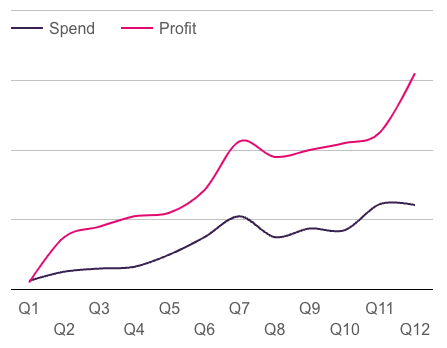
A PPC trial should simply tell you if PPC works for your business or not. At the end of the trial you should have some idea what the minimum profit will be in the future – in the knowledge it will continue to improve.
For a PPC trial to be successful, it needs enough data to be confident of the conclusions from the trial.
Before calculating how much it would cost to get enough data for your business, I thought it would be worth running through some example trials to highlight the importance of getting enough data.
Let’s look at a very simple example of a six-month trial:
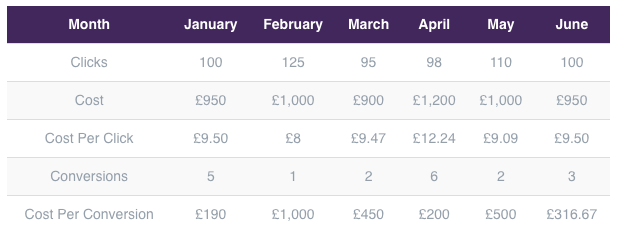
This six-month trial has cost £6,000 and delivered 19 conversions. For the sake of this example, we don’t know if the trial has made a profit because we don’t know how much a conversion is worth.
However, we do know that the trial has failed to answer the “likelihood of success” question. This is because there simply is not enough data to be able to predict future performance.
What would the next three months look like for this trial? There could be 15 conversions or there could be 5.
When you don’t have enough data from a PPC trial, you can’t predict future performance and you can’t properly optimise. For example:
Performance could be transformed with this kind of knowledge. With so little data to work with, this trial was doomed from the start because the budget was too low.
With a cost per click of £9.50 and a budget of £6,000 – 628 clicks is all we have to analyse. 3% of clicks converted leaving only 19 conversions. This budget is inadequate for testing this business in PPC.
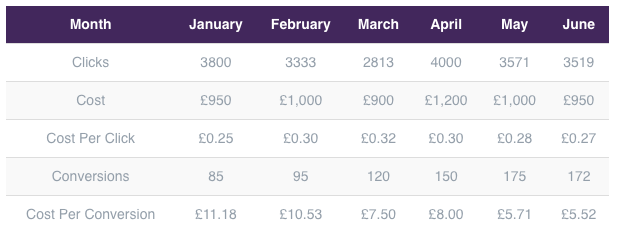
Cost per conversion has improved consistently over this six-month trial. The trial has generated sufficient conversion data to learn what has worked and what has not – and the account has been properly managed.
In this example trial, advertising messaging will have been testing and optimised, keywords optimised along with a full range of changes based on testing and the resulting conversion data.
This is how the first six months of a PPC trial should look – everything else remaining equal. Whoever is managing this account is doing a good job of optimising the campaign and reducing the cost per conversion.
Of course, we still do not know what the profitability of this trial is as we do not know the value of a conversion.
However, we can much more confidently predict the future performance. £5 per conversion seems stable with two consecutive months. Some early wins have been found and normally you should expect further improvements over time.
With this information you will know how profitable the campaign is likely to be in the future. With this information you can re-look at the PPC campaign compared to your other options.
This trial is has a cost per click of just £0.29 and the budget is £6,000 resulting in 21,036 clicks to analyse. We have also generated 797 conversions. This budget is more than adequate for testing this business in PPC.
In fact, you could probably have run the test with significantly lower budgets and still been able to answer the key question – “how likely is PPC to generate profit”.
In the next section, I’ll give a guide on how to estimate a budget for an AdWords trial. This will give you a very rough idea of how much you should spend on a trial. Emphasis on the rough.
The more budget you have for your AdWords trial, the quicker you will learn and the more accurate the results of your trial will be. However, you should aim to spend the minimum required to get an accurate idea of how profitable PPC could become for you.
You don’t necessarily need 800 conversions in a trial to get a good idea of future profitability.
When we calculate a budget for a trial we usually give a recommended band of spend based on the spread of traffic and CPC prices across a full range of keywords from a range of sources.
The next steps take you through a simplified version of this process. At the end of this you should have at least a rough idea of how much you would need to spend to trial AdWords properly.
It is important to state that this should work for roughly 85% to 90% of organisations. The following process is unlikely to work if:
How many conversions you need per month to run a valid trial depends on your business and what you count as a conversion.
If you sell 1,000 different products online, you will need a lot more conversions to make any kind of assessment. This is because you have an additional variable in terms of the profitability of each product.
If you have one conversion goal – like a subscription service or lead generation then you will need fewer conversions to learn how well PPC could work.
As a very general rule of thumb, if you have one conversion goal to optimise towards then use 20 conversions per month as a minimum.
If you have an ecommerce website with several hundred products you might need 100 conversions per month.
If you have thousands of products to sell online, then you may need several hundred. For the purposes of estimating a rough budget, use a maximum of 300 conversions. Even if this isnt enough to test all of your products on your website, it should be enough to test a good percentage.
As this is a rough calculation, don’t get too concerned with getting this figure right. Just get a feel for how many conversions you’ll need based on the numbers above.
The first step in estimating your cost per click is to choose some keywords. Because this is a very rough calculation, you don’t need to worry about building a list of thousands or paying for keyword tools.
To do this part you will need access to Google’s keyword tool. However, to get access to the keyword tool, you will need an AdWords account first.
Signing up for AdWords is easy and free – follow the instructions on https://support.google.com/adwords/answer/6366720 – have a read through and click sign up for AdWords. I recommend not using AdWords express.
When you’ve done this – login to AdWords and click on three dot symbol in the top right and then the Keyword Planner as in the image below:
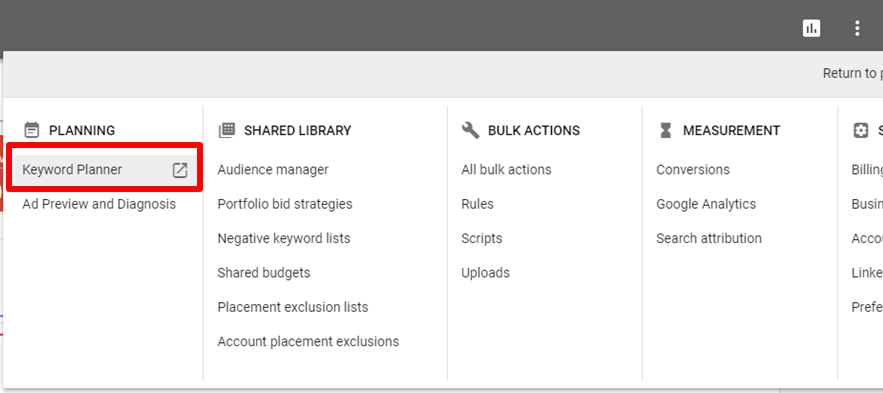
If you are still in the old AdWords interface you can find the keyword planner under the “Tools” menu option.
Once you are in the keyword planner, click the top option “Search for new keywords using a phrase website or category” to load the form below:
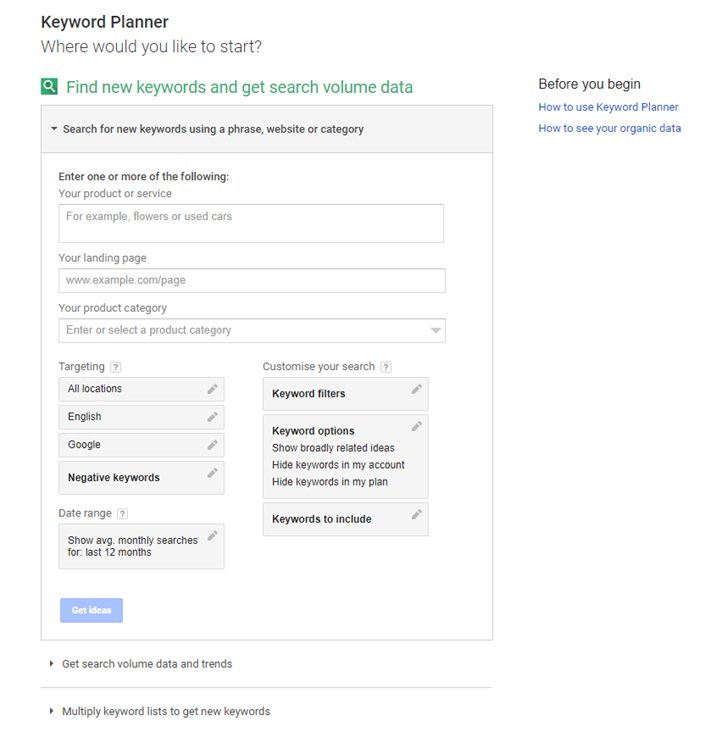
Now the tricky part – pick two or three keywords that describe exactly what you do and type them into the top box.
A common mistake here is to pick keywords that might be more appropriate to another type of business. It is important to only pick those terms where you can be confident that your service could help 90% of those searching.
For example – if you are an accountant your keywords might be “accountant”, “SME accountant”, “fixed fee accountant”, “accountant in location” etc. Your keywords will not be “tax advice” (a tax advisor would be more appropriate), “corporation tax” (this is a very general term), “exit strategy” (probably more likely to speak to a business selling company) etc. These could be keywords to test in the future but for the purposes of estimating a rough budget we just need the people looking exactly for what you are offering.
The best way to check if a keyword is good to use to estimate the budget is to search for it in Google. If no ads appear when you search do not include the terms. If no companies advertising on the terms are direct competition, do not include those terms.
In the example below I have used a UK wide plumbing company as an example.

The first step is to change the location – this is in the top left menu. Click the pencil, add your locations (and remove unwanted locations).
Have a look through the keywords and click on the right pointing arrows below “Add to Plan” to add them into a new adgroup.
When adding keywords, only add those keywords where:
• You can service 90% of those people searching for the keyword
• Some ads appear on the search results page
• When ads appear, at least one of these is in direct competition with you
When you’re done just click on the review plan button on the right hand side to go to the next step:
When you’ve clicked on next step, you’ll see a page that looks something like:

Make sure the location is set to where you can service your clients (click the pencil icon under the “Enter a bid” box). This should carry across from the previous page but always worth checking.
Now, in the “Enter a Bid” box keep entering bids until your average position in the table gets very close to 1.2.
When you get to this point have a look at the “Avg. CPC” number which in this example is £3.98.
Because this data from Google is very rough, we’ll take an extra step of +/- 33% to this CPC figure – giving us between £2.62 and £5.29.
If you look in the cost column of the table, this should give you a very rough idea of how much you could spend each day on AdWords on the keywords you have chosen, if you wanted to.
Make a note of figure in the cost column.
If you already know your conversion rate then just use that figure.
However, if you’re unsure just refer to the tables below to get a rough idea.
Here is a graph from smart insights for lead generation by industry type:
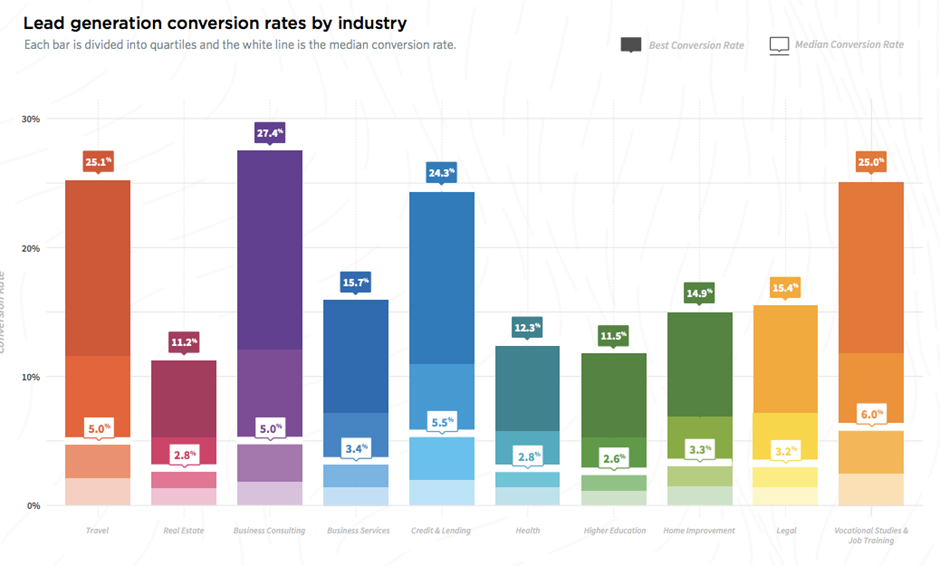
If you take the median for the industry closest to yours. For the plumbing example, I’d take an average of real estate and home improvement – roughly 3%. If you are using landing pages you should expect to achieve above the mean. I would expect that a landing page we created for a plumber would convert at 10% at least.
I simply can’t find a graph or any benchmarking for ecommerce. If you have an ecommerce site let’s just go with the average of 4.5%.
We now have everything we need to calculate a rough PPC budget.
The formula for the budget is:
Min Leads Required / Expected Conversion Rate * Estimated CPC = Min Budget
So in my example of a plumber I have two CPC values – £2.62 and £5.29, an estimated conversion rate of 3% and a minimum number of leads of 20.
So at the upper CPC the formula works out at:
20/3% = 667 * £5.29 = £3,528
The Lower CPC works out at:
20/3% = 667 * £2.62 = £1,747
This is the recommended monthly minimum budget for the plumber example. It is possible to run a trial for a UK wide plumber for around £2.5k per month in advertising costs. For a 6 month trial the recommended AdWords spend would be £15k.
We almost always recommend a 6 month trial, although it can be possible to run a trial with as little as 3 months. Take your monthly figure and multiply it by 6 to get the total trial budget.
At this point it is worth checking that the estimated cost figure in step 3 is very similar or higher than your recommended budget.
If the required budget is considerably higher than the cost figure then it could be that not many of your potential customers are searching for your business in Google.
Go back and see if you have missed any keywords, and run the process again with the new keywords.
The lower the search volume in Google, the less accurate the tool becomes.
If you have any trouble with any part of this process get in touch and we’ll do our best to help.
What we’ve calculated here is the advertising spend recommended to run a trial in AdWords – the net cost will be much lower.
You should be making sales virtually straight away to offset the cost. Don’t forget that you are running this to make a profit. Even if the trial is unsuccessful, it is very unlikely you will generate zero revenue.
How much profit you make from PPC depends not only on a professionally run PPC/AdWords campaign but also on how your business competes with your new search engine competitors. This is a blog article for another time.
If you have a bigger number than you were hoping for fell free to get in touch – we’ll check the numbers for you and let you know the key challenges for your business.
This approach to calculating a minimum budget is essentially a simplified approach to the one we use to estimate budgets for those looking to trial PPC and AdWords.
It is very important to state that this is a rough calculation because:
• Bid estimates from Google are rough
• They are based on keywords chosen – which is only a rough estimation of the account
• The conversion rates from PPC are estimated – even if you already know your conversion rates from other sources doesn’t mean the same rate will apply to PPC
However, if you were completely in the dark about what your PPC trial budget should be then this should give you a ballpark figure.
It is important to state that this works for roughly 85%/90% of the time. As I mentioned earlier, this does not work for all types of organisations. Where this approach is likely to fall down is in the following circumstances:
Get in touch if you want some help from ppc marketing agency in calculating a trial budget for AdWords or PPC.
In the next part of this blog we look at how to work out if you are spending too much or too little on existing PPC campaigns.